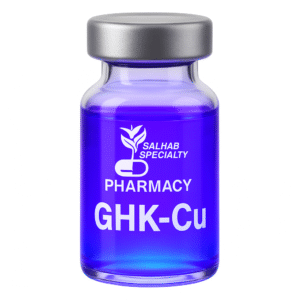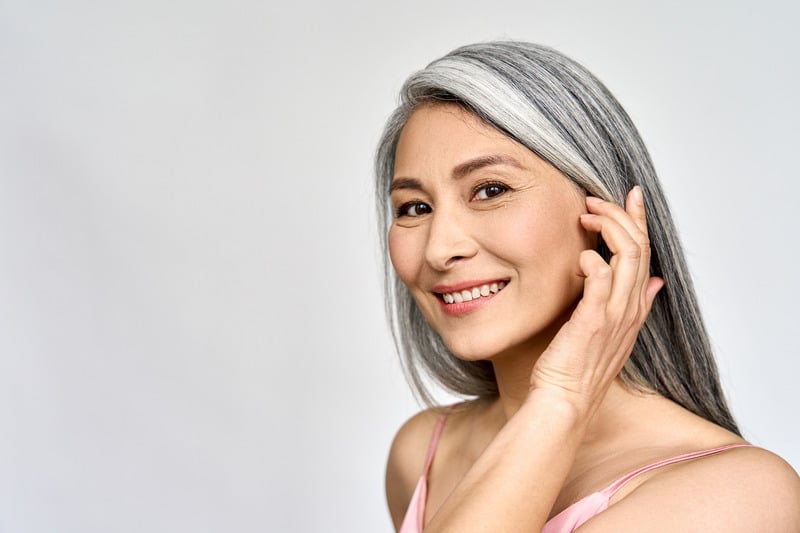Hair loss affects millions of men and women worldwide. From genetic factors to stress, nutrient deficiencies, and hormonal imbalances, there are countless reasons hair may thin or fall out. While treatments like minoxidil and finasteride are widely used, many people are now searching for more natural, science-backed alternatives. One compound that’s gaining attention in the hair restoration world is GHK-Cu — a copper peptide that not only supports skin health but has shown promising results for stimulating hair growth.

If you’ve been looking for a way to encourage thicker, fuller hair without harsh chemicals, GHK-Cu may be worth your attention. In this guide, we’ll explore exactly what GHK-Cu is, how it works on hair follicles, the research behind it, how to use it effectively, and the potential results you can expect.
What Is GHK-Cu?
GHK-Cu stands for Glycyl-L-Histidyl-L-Lysine-Copper, a naturally occurring copper peptide found in human plasma, saliva, and urine. Discovered in the 1970s, GHK-Cu plays a crucial role in wound healing, tissue regeneration, and inflammation control. Over time, its concentration in the body declines with age, which may be one reason why healing and hair growth slow down in older individuals.
In topical or serum form, GHK-Cu can be applied directly to the scalp, where it penetrates the skin and interacts with hair follicle cells to encourage growth and strengthen existing hair strands.

How GHK-Cu Stimulates Hair Growth & Stops Hair Loss
GHK-Cu appears to promote hair regrowth through several mechanisms:
Improving Blood Flow to Hair Follicles
Copper peptides encourage angiogenesis — the formation of new blood vessels. This improves blood circulation to the scalp, delivering oxygen and essential nutrients that hair follicles need to grow.Extending the Anagen (Growth) Phase
Hair growth happens in cycles: anagen (growth), catagen (transition), and telogen (rest). GHK-Cu helps extend the anagen phase, meaning follicles stay in growth mode longer, producing thicker, healthier hair.Reducing Inflammation and DHT Damage
Inflammation around hair follicles and excess dihydrotestosterone (DHT) are leading causes of hair loss. GHK-Cu’s anti-inflammatory properties help create a healthier scalp environment, making it harder for DHT to damage follicles.Boosting Collagen and Extracellular Matrix Production
Collagen and the extracellular matrix provide structural support to hair follicles. By stimulating their production, GHK-Cu strengthens follicle anchoring, reducing breakage and shedding.Activating Stem Cells in the Follicle Bulge
Some research suggests that GHK-Cu may awaken dormant follicles by stimulating stem cells in the scalp, potentially bringing back hair in areas of thinning.
Scientific Evidence Supporting GHK-Cu for Hair Regrowth
While copper peptides have been studied for decades, interest in their use for hair restoration has exploded in recent years. Here are some key findings:
A 1993 study found that GHK-Cu increased hair follicle size and improved hair shaft thickness in animal models.
Research published in the International Journal of Cosmetic Science showed that copper peptide complexes applied topically led to increased hair density and reduced hair loss in participants.
Dermatology case studies have documented noticeable regrowth in individuals using GHK-Cu serums for several months, particularly when combined with microneedling.
Laboratory studies confirm that GHK-Cu stimulates the production of vascular endothelial growth factor (VEGF), which supports blood supply to hair follicles.
How to Use GHK-Cu for Hair Growth
The method and frequency of GHK-Cu use can significantly influence your results. Here’s a step-by-step guide:
Choose the Right Product
Look for high-quality serums or sprays containing GHK-Cu as the main active ingredient. Avoid formulas with too many fillers or harsh chemicals.
Application Method
Apply directly to the scalp in areas of thinning.
Massage gently for 1–2 minutes to improve absorption.
Use after showering, when hair and scalp are clean.
Frequency
Most users apply GHK-Cu once or twice daily. Consistency is key for noticeable results.
Combine With Microneedling for Enhanced Absorption
Microneedling creates tiny microchannels in the scalp, allowing peptides to penetrate more deeply and stimulate follicle repair.
Pair With Hair-Friendly Lifestyle Habits
Eating a nutrient-rich diet, managing stress, and avoiding excessive heat styling will help support results.
What Results Can You Expect?
While everyone’s hair growth rate differs, here’s a general timeline:
First 4–6 Weeks: Reduced shedding, healthier scalp appearance.
2–3 Months: Early signs of new growth along the hairline or crown.
4–6 Months: Noticeable increase in hair thickness and coverage.
9–12 Months: Full cosmetic benefits become visible.
Results can vary based on the cause of hair loss, age, and product quality.
Safety and Side Effects
GHK-Cu is generally well-tolerated. Side effects are rare but can include:
Temporary scalp redness or irritation
Itching or mild dryness
To minimize reactions, start with a lower frequency and patch-test before applying to the entire scalp.
Comparing GHK-Cu to Other Hair Loss Treatments
GHK-Cu: Stimulates follicles, reduces inflammation, improves blood flow. Pros: natural, few side effects, supports skin health. Cons: may take several months for results.
Minoxidil: Increases blood flow to follicles. Pros: widely studied, available OTC. Cons: possible shedding phase, daily commitment.
Finasteride: Blocks DHT. Pros: high success rate in male pattern baldness. Cons: possible sexual side effects.
Where to Find GHK-Cu Products
GHK-Cu is available in:
Topical serums (most popular for hair growth)
Leave-in sprays
Shampoos & conditioners (less concentrated, better as supportive care)
When shopping, choose products from reputable brands with third-party testing for purity and potency.
GHK-Cu + Microneedling: The Hair Growth Power Duo
If you want to maximize results, combining GHK-Cu with microneedling can be a game-changer. Microneedling boosts scalp absorption and triggers wound-healing pathways, which GHK-Cu further amplifies. This combination often leads to faster, more noticeable regrowth.
Medication Request
Call (813) 785-4768 to speak with a physician and order GHK-Cu today!
Final Thoughts: Is GHK-Cu Worth Trying for Hair Growth?
GHK-Cu offers a promising, well-tolerated option for those seeking thicker, fuller hair. Backed by decades of research on tissue regeneration and skin repair, it works by creating a healthier scalp environment, extending the hair’s growth phase, and supporting follicle strength.
While it’s not an overnight solution, consistent use over several months may deliver impressive results — especially when paired with other healthy hair practices like a balanced diet, stress management, and gentle scalp care.
If you’re ready to explore a natural yet scientifically supported path to hair restoration, GHK-Cu could be the missing link in your hair care routine.



